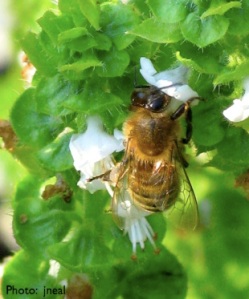
Honey bee
Purdue Extension has a new publication PROTECTING POLLINATORS IN AGRONOMIC CROP PRODUCTION with suggestions for growing crops in a manner that reduces harm to pollinators. Insecticide use on crops such as corn and soybeans can have negative impacts on pollinators. How can the negative impacts be minimized?
The use of GMO crops has reduced the numbers of insecticide applications, the greatest risk to pollinators. GMO crops, which have little or no direct negative effect on pollinators are a “win” for pollinators. However, the seed industry has aggressively marketed seed treated with neonicotinoids. Neonicotinoids have the highest bee toxicity of any pesticide class. The use of neonicotinoid seed treatments is so widespread, it can be difficult for growers to purchase untreated seed. One recommendation is for growers to request seed that is not treated with neonicotinoids. In the overwhelming majority of cases, the added cost of the neonicotinoid seed treatment outweighs benefits. If enough growers request them, untreated seeds would become more widely available and could both protect pollinators and reduce the cost of seeds.
Other recommendations are:
Follow pesticide label rules and pay special attention to the pollinator protection statements on many of the newer labels.
Use modern IPM practices that minimize the number of insecticide treatments and maximize profits.
Consider bee toxicity when choosing among available insecticide options.
Modify practices to avoid insecticide drift onto non-target areas. This includes avoiding dust formulations, spraying at times such as late evening to early morning when the wind speed is slowest, using ground application instead of aerial application, and avoidance of sprays that could contaminate neighboring crops in bloom.
The publication also recommends establishing communications between growers and beekeepers who have hives within a 3 mile radius of the crop. Beekeepers can limit honeybees from foraging in recently treated crops if they have at least a one day notice of an planned insecticide treatment.
Pesticides provide benefit to growers, but they can also harm beekeepers and pollinators. The goal is to manage crop production to maximize the benefits and minimize the costs to others and the environment.

Pingback: Living With Pollinators – Entomo Planet